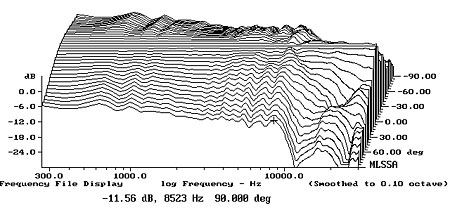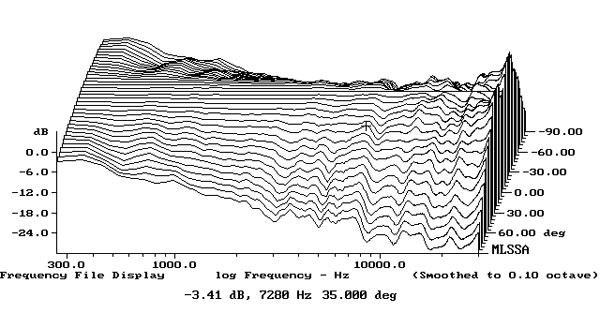What "audible distortion"?
Shirley, you can't be serious.
What do you think the goals are in engineering a good speaker driver and why?
What do you think the goals are in engineering speaker cabinets and why?
What do you think the goals are in various crossover designs, and why for instance they seek to suppress the influence of driver break up modes?
Why do you think most of the designs lauded by ASR members seek a generally flat on-axis frequency response (with evenly sloping off axis response)?
Etc etc.
If you are truly baffled about what "audible distortion" we could be discussing, look up:
Linear Distortion. Harmonic Distortion. Intermodulation Distortion, and others.
What "neutral sonic information"? How do you know what is "from recording" without transduction? Answer, you have no clue, but since you don't know about Circle of Confusion...self explained.
Yes, that must be it. I'm a long time ASR member with thousands of posts and I've never heard of Toole's work or the Circle Of Confusion. Never discussed the issue ad nauseam either. You've got me there.

Seriously...slow down...practice a bit of charity by actually engaging in conversation where you want to understand someone, rather than pose questions assuming "gotchas."
What I meant by "neutral sonic information" is sonic detail about a recording that comes from netural, low distortion reproduction, rather than from goosing up certain frequency ranges that either give the impression of "more detail" or that raise the amplitude and hence audibility of certain details that would otherwise be less noticed or discernible. I presume this phenomenon isn't totally foreign to you I hope? (BTW, I work in post production sound for film/TV - Sound Design - so I'm quite aware of how sound can be manipulated via EQ and many other ways to achieve various audible results).
Based on what evidence any of that matters?
Are you really suggesting the engineering in regards to speaker drivers, cabinet design, crossover design etc...doesn't matter? Or that...
there is no evidence it matters?
Again...what in the world do you think audio engineers have been trying to achieve all these years when they set about designing speakers? Your desire to get to some
sort of pre-set "gotcha," smoking out rascally subjectivists, is leading you to some very strange posts.
Speakers a 3D radiators. "Flat frequency response" where? What distance and azimuth? They have thousands of "Frequency response". Probably missed Toole mentioning spin data...
Yes, never heard of spin data. On a site in which Toole participates and in which all speaker reviews recieve spin data. Again...you know me too well.

You are aware, right, that the work of Toole and others about why a "good" speaker design seeks generally flat on-axis response (again, not ignoring the influence of off axis behavior). You can put the goal in terms of maintaining accuracy to the signal coming out of your source/amp etc. Or you can simply put it in terms of preference - the blind testing research indicated that most people prefer the sound of a "neutral" speaker - generally flat on-axis sound, which is what our brains primarily use to interpret the sound of a source. In which case, there are all manner of ways a speaker can deviate from a flat frequency response, right? Audibly so. Right? This would be a "distortion" relative to the goal you are seeking to achieve, right? You can look up more about speaker design and figure out the rest I hope.
Based on what evidence? Oh wait, sighted "listening" revealing "new details" again...
There you go again. Why do you assume this?
If we want to be more sure of any such conclusions, the ideal way to evaluate would be blind listening, for instance similar to the type cited by Floyd Toole.
Please notice: Nowhere did I propose that the questions I asked were to be settled by sighted listening. And I have long defended the relevance of blind testing for any endevour in which we require stronger evidence than mere sighted anecdotes. This is why I've been explicit in this very thread (and many others) that nobody need take my anecdotes as settling anything at all on the matter, and that they can be ignored for the question at hand.
But you wouldn't know this because you are unaware of what I've argued for on this forum, and prefer to keep leaping to unfounded assumptions.
Yeah that's it Matt.

Yes, you were wrong about all your disparaging suggestions. Wrong that I didn't know or didn't care about the relevance of science and blind testing to audio gear. Wrong about my being unfamiliar with Floyd Toole's work and it's implications. Wrong that I was assuming sighted listening like mine settles any such questions. And not a single question you posed results in the "gotcha" you seem to have assumed. (And...in terms of actual personal experience: how many blind tests have you participated in? Just curious).




 Seriously...slow down...practice a bit of charity by actually engaging in conversation where you want to understand someone, rather than pose questions assuming "gotchas."
Seriously...slow down...practice a bit of charity by actually engaging in conversation where you want to understand someone, rather than pose questions assuming "gotchas."